Intraoral Scanners Market Size
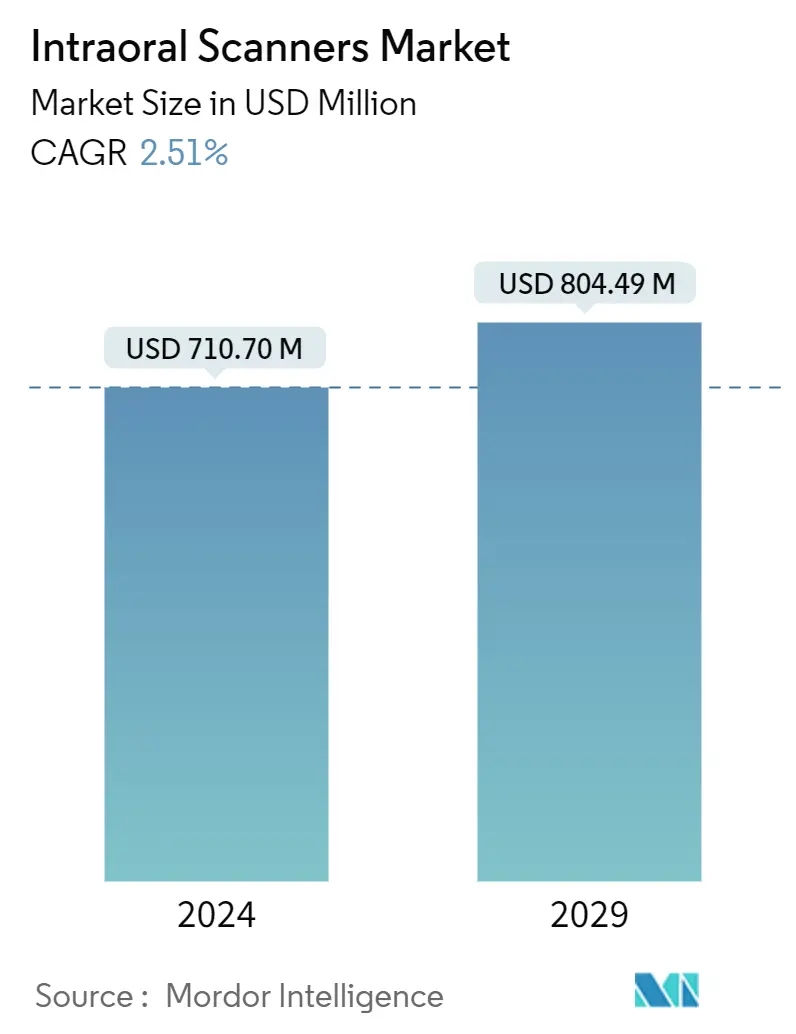
| Study Period | 2021- 2029 |
| Market Size (2024) | USD 710.70 Million |
| Market Size (2029) | USD 804.49 Million |
| CAGR (2024 - 2029) | 2.51 % |
| Fastest Growing Market | Asia-Pacific |
| Largest Market | North America |
Major Players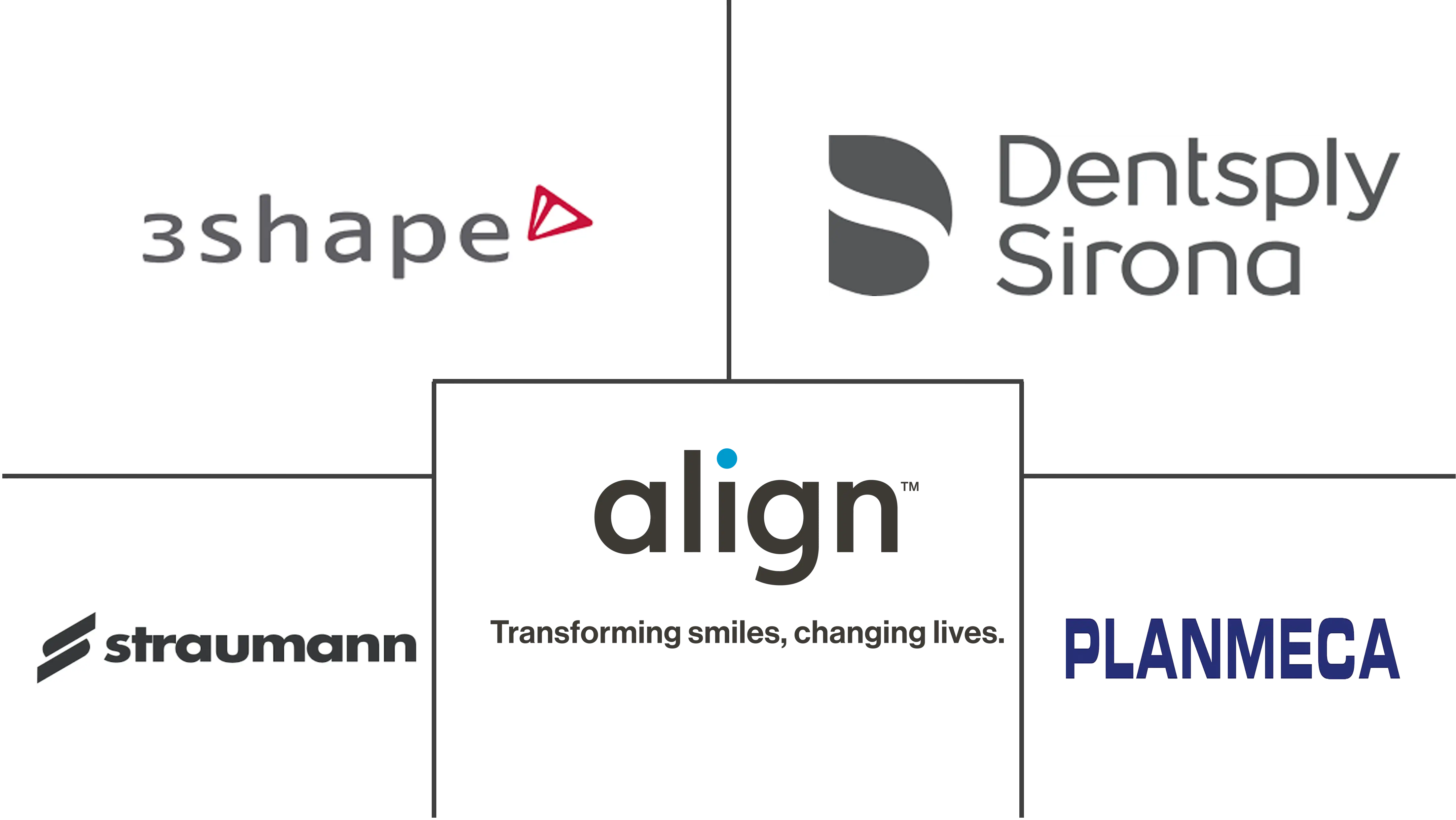
*Disclaimer: Major Players sorted in no particular order |
Intraoral Scanners Market Analysis
The Intraoral Scanners Market size is estimated at USD 710.70 million in 2024, and is expected to reach USD 804.49 million by 2029, growing at a CAGR of 2.51% during the forecast period (2024-2029).
The COVID-19 pandemic contributed largely to transforming the growth of intraoral scanners markets. Initially, the outbreak of COVID-19 showed a substantial effect on the intraoral scanner market because patients' visits to dental clinics and hospitals were significantly reduced due to the global social distancing and lockdown measures taken by governments. During the initial phase of the pandemic, the American Dental Association (ADA) published recommendations for dental emergency and non-emergency care. Apart from conditions involving acute pain, infection, or trauma, the removal of teeth not showing any symptoms, and restorative dentistry, which includes the treatment of asymptomatic carious lesions and cosmetic dental procedures, all were considered non-emergencies by the American Dental Association (ADA).
However, during the COVID-19 pandemic, tooth fractures, dental treatment cementation, pericoronitis, etc., were identified as emergency dental procedures. Hence, it was observed that the COVID-19 pandemic had a significant impact on the market studied. However, currently, the market has reached pre-pandemic in terms of demand for the intraoral scanner.
Additionally, the significant factors responsible for the growth of the intraoral scanner market include an increase in the geriatric population, a rise in dental disorders, and technological advancements. For instance, the high prevalence of dental caries due to unhealthy eating and lack of oral care among populations in various countries is the key factor driving the market’s growth. For instance, as per the National Dental Epidemiology Program survey of 5-year-old children in England in 2022, the national prevalence of children with enamel and dentinal decay was 29.3%. As per the same source, regionally, this ranged from 23.3% in the Southwest to 38.7% in Northwest England. The introduction of intraoral scanners in the dental devices market has modernized the dental practice landscape. These have eliminated the limitations of taking tooth impressions and helped dentists instantly transfer and manipulate data. Thus, such features are likely to increase the adoption of intraoral scanners across healthcare facilities, thereby contributing to market growth.
The increasing geriatric population is expected to facilitate market growth as the elderly population is prone to developing dental disorders because of salivary changes related to aging, consumption of a poor diet, and exposure to dental roots due to gingival recession. For instance, according to the report published by the World Economic Forum in September 2023, more than 1 in 10 people in Japan are aged 80 or over in 2023. In addition, the National Institute of Population and Social Security Research projected that those aged 65 or older will account for 34.8% of the total population in 2040. Thus a positive correlation between the senior population and an increase in incidences of tooth loss and other dental-related disorders is expected to positively impact the market growth.
Thus, factors such as rising dental disease prevalence owing to the rising geriatric population, product launches, and approvals over the forecast period are likely to facilitate market growth. However, the lack of skilled professionals in developing economies such as India and China and the high cost of intraoral scanners may restrain market growth.
Intraoral Scanners Market Trends
Standalone Devices Segment is Expected to Witness Strong Growth in The Coming Years
Standalone devices are expected to witness promising growth due to the improved workflow of dental professionals in oral scanning procedures and improved outputs of these devices. Furthermore, due to the introduction of miniature portable intraoral scanners in the market, incorporating the side-oriented tip in small intraoral scanners has made buccal surface scans much more accessible, quicker, and more effective. Thus, the enhanced output offered by these devices is expected to fuel the segment's growth.
Oral illnesses affect people throughout their lives, causing pain, suffering, disfigurement, and sometimes death. They are a significant health burden for many nations. For instance, according to the data published by the National Institute of Dental and Craniofacial Research in April 2022, it has been observed that tooth decay affects about 90% of adults aged 20 to 64 years, and gum diseases affect almost 50% of adults aged 45 to 64 years, annually, in the United States. Thus, the rising dental diseases are likely to boost the demand for intraoral scanners for effective disease detection.
Furthermore, intraoral scanners have become increasingly popular in the dental impression market due to their ability to reduce chairside time and improve the accuracy of final restorations. While traditional impression materials are still widely used, the adoption of intraoral scanners represents a significant shift toward digital dentistry, offering precision, patient comfort, and the overall quality of dental care. As technology continues to advance, the role of intraoral scanners is likely to expand further, influencing the future landscape of dental impressions in dentistry. For instance, in September 2022, 3Shape launched a wireless intraoral scanner called TRIOS 5, which features ScanAssist intelligent alignment technology that delivers the highest imaging performance and infection control standard. According to the company, TRIOS 5 Wireless features an FDA-cleared, closed autoclavable scanner tip protected by scratch-free sapphire glass to define a new level of hygiene and includes ultra-thin, snug, and near-invisible single-use sleeves to cover the scanner body and minimize the risk for cross-contamination.
Therefore, the studied sub-segment is anticipated to rise over the forecast period due to the benefits associated with scanners, the rising demand for scanners, and the growing focus by significant players on developing and marketing improved scanners.
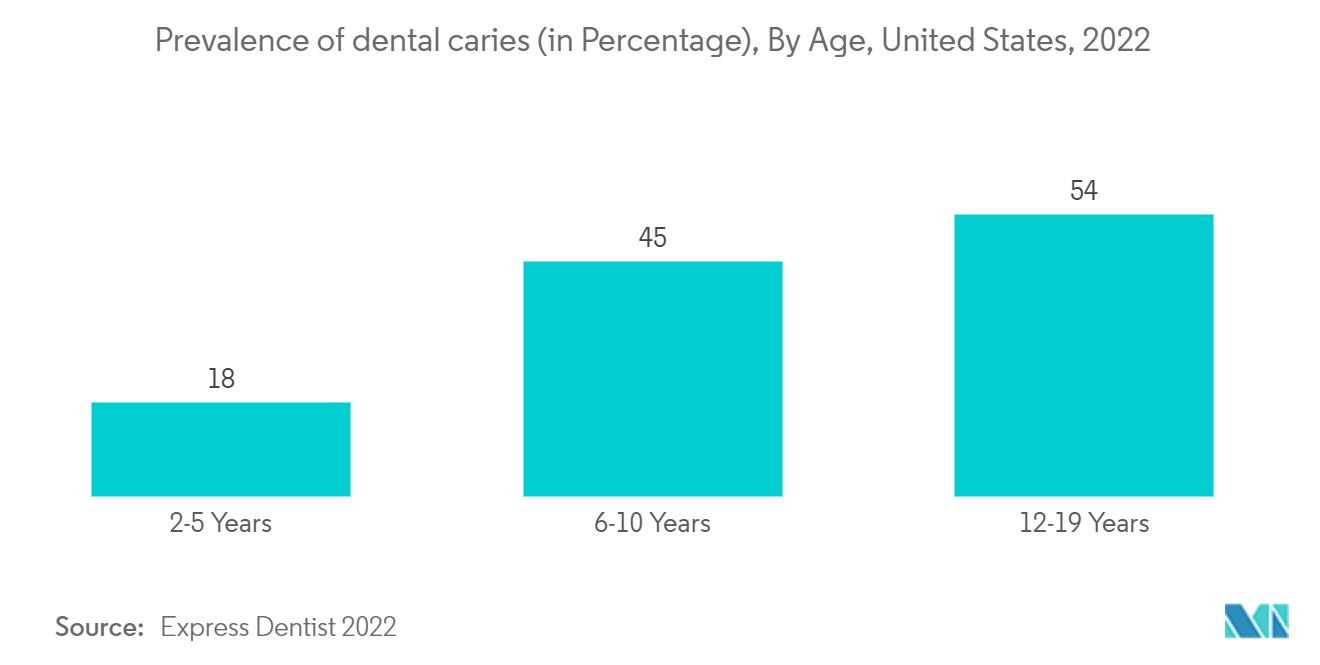
North America is Expected to Hold a Significant Market Share During the Forecast Period
North America is expected to register significant growth over the forecast period. A rise in the geriatric population susceptible to oral disorders, an increasing number of patients suffering from dental problems, and advanced healthcare infrastructure are the key factors propelling the market growth.
The increasing tooth decay in the geriatric population can drive the demand for intraoral scanners in the United States for several reasons. Firstly, as the aging population grows, there is a higher likelihood of oral health issues, including tooth decay and loss, necessitating dental interventions. For instance, as per the April 2022 update by the National Institutes of Health (NIH), about 9 out of 10 adults aged 20 to 64 experienced tooth decay in the United States over the past 2 years. Similarly, according to the 2022 statistics published by the United Nations Population Fund, in Canada, about 19% of the population is aged 65 years and above in 2022. Thus, the growing aging population is expected to increase the burden of dental diseases and is likely to contribute to market growth. Thus, growing tooth decay in the aging population is expected to increase the demand for intraoral scanners to detect the disease and contribute to market growth over the forecast period.
Additionally, as the United States healthcare system develops and dental problems become more well-known, more people are anticipated to visit dentists and hospitals, which will support the expansion of the intraoral scanner market in the region. For instance, in October 2022, the American Diabetes Association (ADA) announced a collaborative Oral Health campaign with Pacific Dental Services (PDS). The campaign aims to increase awareness of periodontal disease (gum disease) and how oral health providers can assist patients in preventing and managing this chronic health condition. Thus, such initiatives are likely to increase awareness about dental health in the country, which is likely to augment the number of dental visits and ultimately contribute to the market growth.
Moreover, favorable reimbursement policies for dental procedures are expected to contribute to the market’s growth. For instance, in September 2022. the government of Canada introduced the Canadian Dental Benefit, an immediate measure to provide low-income families (under USD 90,000 annual family income) in Canada with USD 260 – USD 650 of coverage per child under 12 years. This benefit is retroactive to cover dental expenses from October 1, 2022, and is only available for two reporting periods.
Due to technological advancements, the key market players in the country are launching new and advanced scanners, which are also expected to have a significant impact on the growth of the studied market in the region. For instance, in April 2023, Ori Dental launched the Ori Intraoral Scanner as a modern alternative to traditional dental Polyvinyl Siloxane (PVS) impressions. This intraoral dental scanner is made to be faster, lighter, more accurate, and less expensive than traditional PVS dental impressions.
Therefore, the rising geriatric population, which is more prone to dental diseases, government support initiatives, and reimbursements are anticipated to fuel the intraoral scanners market growth in the region.
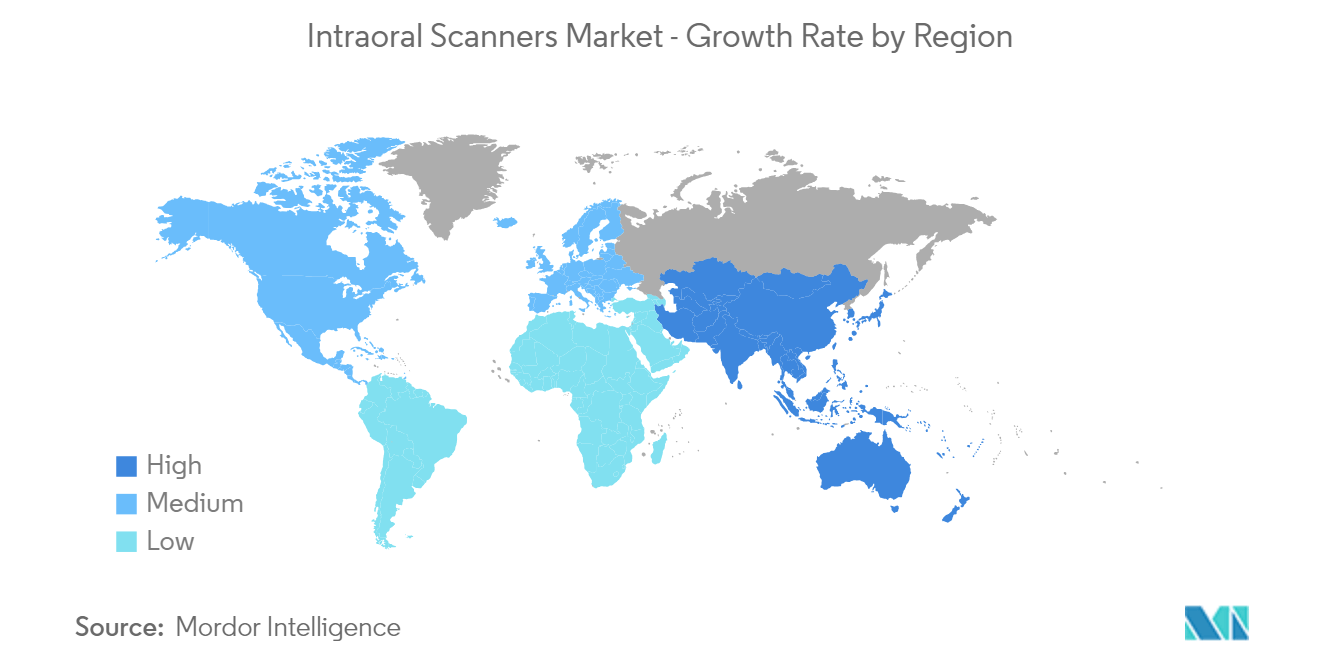
Intraoral Scanners Industry Overview
The intraoral scanner market is competitive and consists of several major players. In terms of market share, a few major players dominate the market. Some companies currently dominating the market are 3 Shape AS, Align Technology Inc., Dentsply Sirona Inc., and PLANMECA OY. Furthermore, the companies adopt various strategic measures such as acquisitions, partnerships, collaborations, and new product launches to expand in the market.
Intraoral Scanners Market Leaders
-
3Shape A/S
-
Align Technology, Inc.
-
PLANMECA OY
-
Dentsply Sirona Inc.
-
Institut Straumann AG
*Disclaimer: Major Players sorted in no particular order
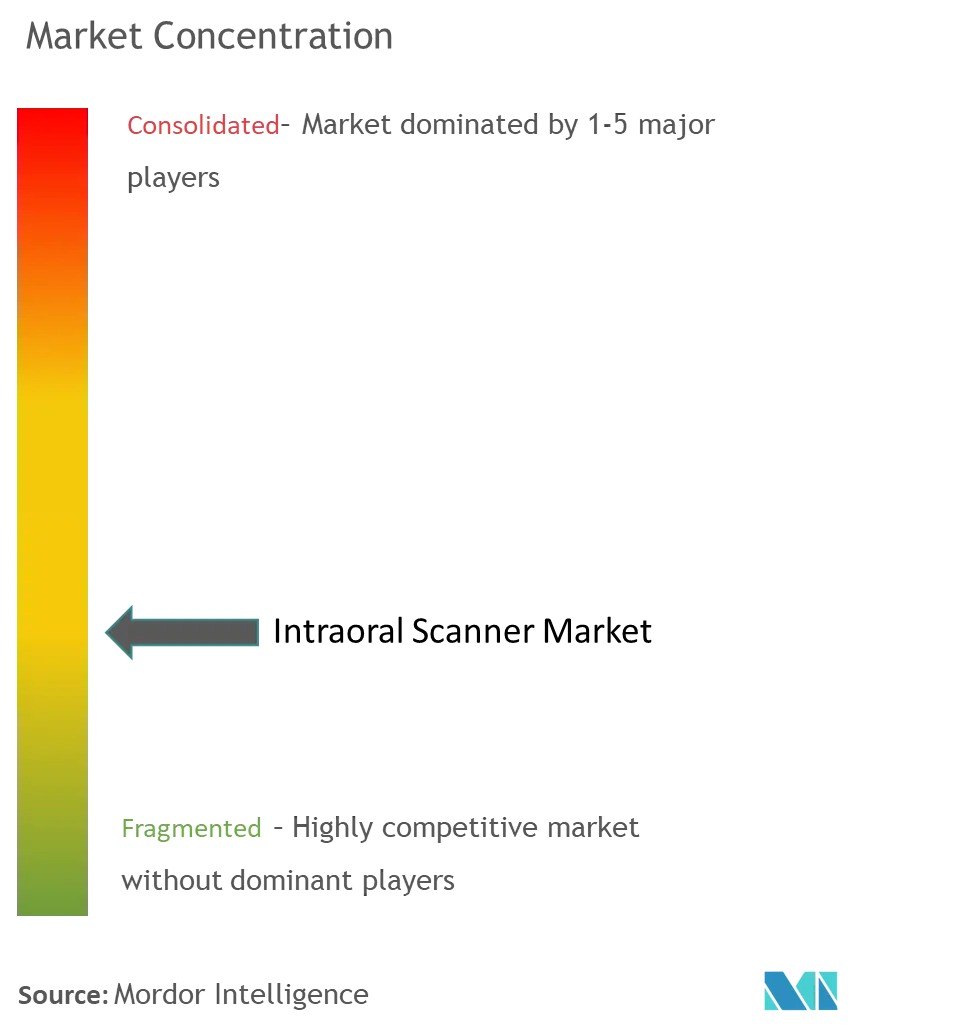
Intraoral Scanners Market News
- March 2023: Freqty Technology, a Chinese high-tech enterprise in the field of digital dentistry, launched the latest and smallest PANDA intra-oral scanner, the PANDA Smart, at the International Dental Show (IDS) in Germany in 2023.
- March 2023: GC launched new solutions during the recent 40th International Dental Show (IDS) in Cologne, Germany. The new Aadva IOS 200 intra-oral scanner is equipped with 4DR technology.
Intraoral Scanners Market Report - Table of Contents
1. INTRODUCTION
- 1.1 Study Assumptions and Market Definition
- 1.2 Scope of the Study
2. RESEARCH METHODOLOGY
3. EXECUTIVE SUMMARY
4. MARKET DYNAMICS
- 4.1 Market Overview
-
4.2 Market Drivers
- 4.2.1 Rapid Technological Advancements
- 4.2.2 Increase in Geriatric Population
- 4.2.3 Rise in Dental Disorders
-
4.3 Market Restraints
- 4.3.1 Lack of Skilled Professionals
- 4.3.2 High Cost of Intraoral Scanners
-
4.4 Porter's Five Forces Analysis
- 4.4.1 Bargaining Power of Suppliers
- 4.4.2 Bargaining Power of Buyers/Consumers
- 4.4.3 Threat of New Entrants
- 4.4.4 Threat of Substitute Products
- 4.4.5 Intensity of Competitive Rivalry
5. MARKET SEGMENTATION
-
5.1 Modality
- 5.1.1 Standalone
- 5.1.2 Portable
-
5.2 End User
- 5.2.1 Dental Clinics
- 5.2.2 Hospitals
- 5.2.3 Other End Users
-
5.3 Geography
- 5.3.1 North America
- 5.3.1.1 United States
- 5.3.1.2 Canada
- 5.3.1.3 Mexico
- 5.3.2 Europe
- 5.3.2.1 Germany
- 5.3.2.2 United Kingdom
- 5.3.2.3 France
- 5.3.2.4 Italy
- 5.3.2.5 Spain
- 5.3.2.6 Rest of Europe
- 5.3.3 Asia-Pacific
- 5.3.3.1 China
- 5.3.3.2 Japan
- 5.3.3.3 India
- 5.3.3.4 Australia
- 5.3.3.5 South Korea
- 5.3.3.6 Rest of Asia-Pacific
- 5.3.4 Middle East and Africa
- 5.3.4.1 GCC
- 5.3.4.2 South Africa
- 5.3.4.3 Rest of Middle East and Africa
- 5.3.5 South America
- 5.3.5.1 Brazil
- 5.3.5.2 Argentina
- 5.3.5.3 Rest of South America
6. COMPETITIVE LANDSCAPE
-
6.1 Company Profiles
- 6.1.1 Medit Corp.
- 6.1.2 3Shape A/S
- 6.1.3 Align Technology Inc.
- 6.1.4 BLZ Dental
- 6.1.5 Condor Technologies NV
- 6.1.6 Densys Ltd
- 6.1.7 Institut Straumann AG
- 6.1.8 Dentsply Sirona Inc.
- 6.1.9 Guangdong Launca Medical Device Technology Co. Ltd.
- 6.1.10 Planmeca Oy
- *List Not Exhaustive
7. MARKET OPPORTUNITIES AND FUTURE TRENDS
** Subject To AvailablityIntraoral Scanners Industry Segmentation
As per the scope of the report, intraoral scanners are digital devices used to capture 3-dimensional images of the internal area of the mouth. The device provides details of soft tissues in the intraoral area through superior-quality images. Intraoral scanners generate videos or capture images, coupled with the fabrication of virtual copies of the intraoral site.
The intraoral scanner market is segmented by modality (standalone and portable), end user (dental clinics, hospitals, and other end users), and geography (North America, Europe, Asia-Pacific, the Middle East and Africa, and South America). The report also covers the estimated market sizes and trends for 17 countries across major regions globally.
The report offers the value (in USD) for the above segments.
| Modality | Standalone | |
| Portable | ||
| End User | Dental Clinics | |
| Hospitals | ||
| Other End Users | ||
| Geography | North America | United States |
| Canada | ||
| Mexico | ||
| Geography | Europe | Germany |
| United Kingdom | ||
| France | ||
| Italy | ||
| Spain | ||
| Rest of Europe | ||
| Geography | Asia-Pacific | China |
| Japan | ||
| India | ||
| Australia | ||
| South Korea | ||
| Rest of Asia-Pacific | ||
| Geography | Middle East and Africa | GCC |
| South Africa | ||
| Rest of Middle East and Africa | ||
| Geography | South America | Brazil |
| Argentina | ||
| Rest of South America |
Intraoral Scanners Market Research FAQs
How big is the Intraoral Scanners Market?
The Intraoral Scanners Market size is expected to reach USD 710.70 million in 2024 and grow at a CAGR of 2.51% to reach USD 804.49 million by 2029.
What is the current Intraoral Scanners Market size?
In 2024, the Intraoral Scanners Market size is expected to reach USD 710.70 million.
Who are the key players in Intraoral Scanners Market?
3Shape A/S, Align Technology, Inc., PLANMECA OY, Dentsply Sirona Inc. and Institut Straumann AG are the major companies operating in the Intraoral Scanners Market.
Which is the fastest growing region in Intraoral Scanners Market?
Asia-Pacific is estimated to grow at the highest CAGR over the forecast period (2024-2029).
Which region has the biggest share in Intraoral Scanners Market?
In 2024, the North America accounts for the largest market share in Intraoral Scanners Market.
What years does this Intraoral Scanners Market cover, and what was the market size in 2023?
In 2023, the Intraoral Scanners Market size was estimated at USD 692.86 million. The report covers the Intraoral Scanners Market historical market size for years: 2021, 2022 and 2023. The report also forecasts the Intraoral Scanners Market size for years: 2024, 2025, 2026, 2027, 2028 and 2029.
What are the growth opportunities in the Intraoral Scanners Market?
The growth opportunities in the Intraoral Scanners Market are a) Potential use in tele dentistry for remote patient consultations and treatment planning b) Opportunities for companies to develop cost-effective intraoral scanner solutions targeted towards these markets
3D Dental Scanners Industry Report
The intraoral scanners market is on an upward growth curve, fueled by enhancements in dental technology and an increased demand for accurate dental care solutions. Key factors propelling this growth include an aging population facing dental challenges and a rise in dental ailments, alongside a shift towards preventive healthcare. The widespread adoption of intraoral scanners is revolutionizing dental care with superior imaging capabilities, providing detailed 3D visuals crucial for orthodontists and other dental professionals. These devices, known for their portability, user-friendliness, and patient comfort, underscore the industry's move towards digital, precise, and convenient dental treatments despite hurdles such as high costs and a skilled workforce shortage. With government actions in emerging markets to bolster the dental and pharmaceutical sectors, intraoral scanners are becoming essential in modern dentistry, indicative of an industry transitioning to digitized care solutions. For detailed insights, Mordor Intelligence™ Industry Reports provide comprehensive analysis, including market share, size, revenue growth rate, and a forecast outlook, available as a free report PDF download.



